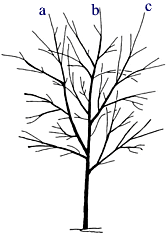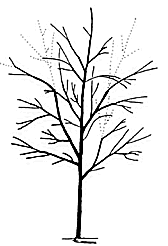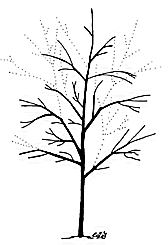Home > Pruning trees > Structural pruning
Structural pruning: the essence of tree care
|
Photo examples: set 1, set 2, set 3 |
 |
 |
Objectives
Increase structural integrity and encourage health and long life by pruning to one dominant leader.
Before pruning Problem - Before pruning, the young to medium-aged tree has three developing leaders or codominant stems (a, b and c). These are likely to develop into multiple leaders, which are considered weaker than trees with one trunk. Large maturing trees usually perform best and last longest if they grow with one main leader. Structural pruning helps the tree develop one main leader and one trunk. |
After light pruning Solution - Reduce the length of (subordinate) leaders 'a' and 'c' using a reduction cut to encourage leader 'b' to grow faster. This will help leader 'b' become the dominant trunk by slowing growth on leaders 'a' and 'c' and allowing more sunlight to reach 'b'. In most cases on large-maturing trees, branches in the lower 15-20 feet of the tree should be kept smaller than half the trunk diameter using this technique. |
After moderate pruning Solution - This moderate pruning treatment is similar to the light pruning treatment. The main difference is here we are more aggressive. Larger holes are left in the canopy following moderate pruning. This might be appropriate if trees cannot be pruned for several years, or if they might never be pruned again. Up to about 40% of foliage could be removed on young trees, if necessary. |
Introduction
Many shade trees in the forest grow straight, tall trunks as they compete with neighboring trees for sunlight. In the landscape, however, the abundance of sunlight all around the canopy encourages trees to develop multiple, competing trunks or leaders. This type of structure is susceptible to mechanical breakage and can reduce life expectancy. But trees with one dominant leader and small well-spaced branches, like trees in the forest, are less likely to suffer this type of mechanical failure. The dominant leader structure also makes trees better able to retard the spread of decay within the tree.
Structural pruning in the landscape aims to develop the strong tree structure we see in the forest. Structural pruning selectively favors a single, dominant leader by suppressing competing leaders using reduction cuts. Reduction cuts shorten stems back to lateral branches at least one-third the diameter of the cut stems. Because future growth is forced into the unpruned leader and growth on pruned branches is suppressed, the ratio of branch diameter to trunk diameter (referred to as aspect ratio) becomes smaller. The small aspect ratio makes the union strong (See: details of aspect ratio). Structural pruning on shade trees should occur regularly when the tree is less than about 20 inches trunk diameter to establish good form early. It is normally performed every few years to gradually encourage more growth in the selected leader. Proper structural pruning should be performed on most tree species that become large at maturity to promote longevity, decrease future maintenance costs, and reduce conditions in the tree that could place people or property at risk.
Strategies
There are six main strategies in executing a structural pruning program. These include the following:
- Develop or maintain a dominant leader
- Identify lowest branch in the permanent canopy
- Prevent branches below the permanent canopy from growing upright or too large
- Space main branches along a dominant trunk
- Keep all branches less than one-half the trunk diameter
- Suppress growth on branches with bark inclusions
Execution
Prune to maintain a dominant leader (one main trunk) by reducing the length of or removing competing leaders. This typically means shortening the longest branches with a reduction cut. Ideally, reduction cuts should be no larger than 2-3 inches diameter on poor compartmentalizers and 3-5 inches diameter on good compartmentalizers. (See: details of decay from reduction cuts). Larger cuts can cause significant decay Do not allow branches with included bark to grow too large because they could split from the tree. This is accomplished by shortening the branch. Regularly reduce the length of low vigorous branches and limbs that will be in the way later and have to be removed; typically this means shorten all branches originating from the lower 20 feet of the trunk. Strive to prevent all branches on the tree from growing larger than half the trunk diameter. Older trees can be pruned in a similar manner to create or preserve good structure.




